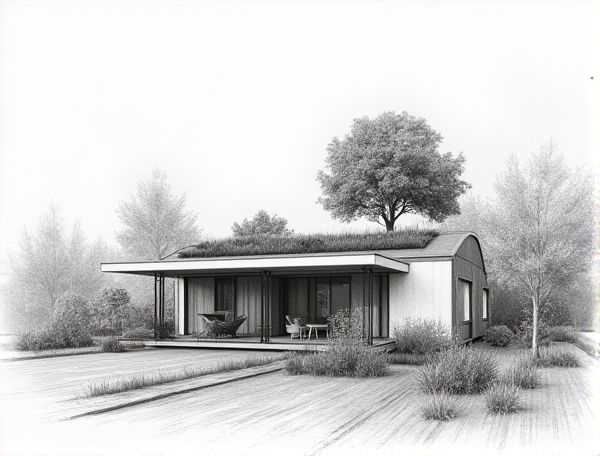
Photo illustration: Eco-home design with living green roof
Incorporating a living green roof into your eco-home design enhances energy efficiency by providing natural insulation and reducing urban heat impact. Discover how this sustainable choice transforms your space while supporting environmental health by reading more in the article.
Introduction to Eco-Home Design
Eco-home design integrates sustainable materials, energy-efficient systems, and smart spatial layouts to reduce environmental impact while enhancing occupant comfort. Incorporating renewable energy sources such as solar panels and optimizing natural light and ventilation reduce utility costs and carbon footprint. Passive design principles, water conservation techniques, and non-toxic materials further contribute to creating a healthy, eco-friendly living environment.
Understanding Living Green Roofs
Living green roofs consist of layered vegetation systems installed atop building structures, enhancing insulation and reducing urban heat island effects. These roofs improve air quality, manage stormwater runoff by absorbing rain, and extend roof lifespan through protection against ultraviolet radiation and temperature fluctuations. Integrating native plants tailored to local climate maximizes biodiversity benefits and ensures sustainable maintenance.
Environmental Benefits of Green Roofing
Green roofing significantly reduces urban heat island effects by providing natural insulation and cooling, lowering energy consumption for your home. Rainwater absorption by green roofs also enhances stormwater management, minimizing runoff and supporting local ecosystems.
Energy Efficiency and Insulation Advantages
Enhancing your home's energy efficiency with advanced insulation materials reduces heat loss by up to 40%, significantly lowering utility bills and maintaining consistent indoor temperatures year-round. Proper insulation also minimizes environmental impact by reducing carbon emissions and increasing overall comfort through improved air quality and noise reduction.
Choosing Suitable Plants for Green Roofs
Selecting drought-tolerant and low-maintenance plants such as sedum, succulents, and native grasses ensures optimal growth and durability on green roofs. These species enhance insulation, promote biodiversity, and require minimal irrigation, making them ideal for sustainable rooftop garden design.
Structural Considerations and Installation
Structural considerations in home designing ensure load-bearing walls and foundation integrity accommodate additional installations like skylights or solar panels without compromising safety. Proper installation requires adherence to building codes and precise alignment with existing frameworks to maintain structural stability and longevity.
Water Management and Drainage Solutions
Effective water management and drainage solutions are essential for protecting your home from water damage and soil erosion. Incorporating permeable pavements, French drains, and rainwater harvesting systems can optimize water flow and prevent flooding. Properly designed drainage systems enhance landscape health while promoting sustainable water use around your property.
Maintenance Tips for Living Green Roofs
Regularly inspect drainage systems on your living green roof to prevent water buildup and root rot while removing debris to maintain healthy plant growth. Your plants will thrive longer by applying organic fertilizers seasonally and monitoring moisture levels to avoid overwatering or drought stress.
Cost Analysis and Financial Incentives
Analyzing construction and material costs reveals opportunities to optimize budgets by selecting energy-efficient systems qualified for tax credits and rebates. Leveraging local and federal financial incentives such as green building grants or solar installation subsidies significantly reduces overall expenses in sustainable home design.
Inspiring Case Studies of Eco-Homes with Green Roofs
Eco-homes featuring green roofs demonstrate innovative use of sustainable materials and natural insulation, significantly reducing energy consumption and improving urban biodiversity. Case studies highlight how integrating native plants on rooftops enhances stormwater management and air quality while creating serene living environments.
 homedesy.com
homedesy.com